Recent Posts
Safety Tips in Case of a Business Fire
5/14/2024 (Permalink)

As a business owner, the safety of your employees and everyone else in your building is in your hands. Are you prepared to respond quickly in the event of a business fire? Follow these safety tips to ensure that you can answer that question in the affirmative.
1. Safety Features
Your two main sources of protection during a fire are your fire suppression system and your fire extinguishers. Have your fire suppression system, including alarm panels, fire doors and sprinklers, inspected regularly. Make sure you have enough working fire extinguishers to place one at least every 75 feet and that they are mounted properly.
2. Fire Codes
Your building is bound by both state and federal fire codes. Exits must be properly marked and the pathways to them unobstructed. Electrical plates must be used to cover all wiring so that none of it is exposed. Comply with all laws and make immediate changes when mandated by fire marshals.
3. Material Labeling
All potentially hazardous or flammable material must be stored properly. It is also essential to label liquids that could easily contribute to a business fire so that anyone who sees them knows what they are.
4. Evacuation Plan
Before firefighters can put out the fire and fire damage specialists can restore your building, everyone must vacate it. Having an evacuation plan helps everyone know what they’re supposed to do. This plan should be posted in prominent areas, especially around exits.
5. Evacuation Practice
Even the best plan is useless unless people know about it. Fire drills are a necessary part of fire preparation. Having a drill twice a year helps your employees practice fire safety plan so that they know what to do in case of an emergency.
The best business fire protection is preparation. Keeping your building up to code and enforcing safety measures can help you prevent most fires, and having a workable fire suppression system and evacuation plan can help get people to safety for the fires you can’t prevent.
The 3 Signs of Mold
5/14/2024 (Permalink)
Mold is a type of fungus that develops from tiny spores that float around in the air, both indoors and outdoors. Mold is often found in humid or moist places, and if allowed to grow unchecked, it can present issues for a building. With that in mind, we offer this quick list to help you identify mold is growing in your building:
1) Musty Odor
Even if you cannot see mold, it can be in your home or business. A very common indicator of the fungus is its smell. When mold grows in an area of your building, you will notice a pungent and musty smell. Take action immediately when you notice the odor. Mold overgrowth can cost you a great deal of money and even your health. You may not be aware of the full extent of the problem until professionals check in between walls and under floors.
2) The Appearance of Mold
Mold may look like cotton, granules, or leather. It can appear in various colors like white, green, gray, black, brown, or yellow. Unfortunately, many people ignore small mold and mistake it for soot or ordinary dirt. Take immediate action when you see tiny discolored and fuzzy growth on furnishings or the surface of building materials.
3) Water Leaks
If you notice water leaks from ceiling pipes, water stains, or standing water, mold might become an issue. Water leaks cause moisture, and that provides an excellent growing place for mold. Check for discoloration or watermarks on carpets, walls, and other materials for hidden mold.
Any business or home can face a fungus fiasco. If you suspect that you have a mold problem, SERVPRO® can inspect the property. Mold remediation is one of our specialties and we can eliminate the issue safely. We also invest in state-of-the-art equipment and continuous training that ensures your home or business is quickly and efficiently restored.
Give us a call today!
Storm Safety Tips
5/8/2024 (Permalink)
Depending on the season and your location, your business may be vulnerable to damage from intense rain storms, tornadoes or hurricanes. Following several key safety guidelines can help you protect your building and safeguard the wellbeing of your staff.
- Keep Trees Trimmed
Tree branches can become dangerous objects during strong winds. To minimize the risks of broken windows and roof damage, you should keep trees adjacent to your property neatly trimmed and routinely remove dead branches.
- Stay Away From Windows and Skylights
Flying debris can easily shatter windows and skylights. As a precaution, everyone should move away from these structures during a severe storm with high winds or hail.
- Elevate Essential Equipment
A significant rainstorm can increase the risk of flooding. If floodwaters enter your building, essential equipment, including components of your HVAC system, may be vulnerable to water damage. To alleviate this concern, you should elevate important devices off the floor.
- Move to an Internal Room
In the event of a tornado, seeking adequate shelter is essential. Your staff should promptly move to the basement or a windowless, interior room on the lowest level of the building.
- Avoid Using Electronic Equipment
Because cords conduct electricity, using electronic equipment during a thunderstorm can be dangerous. Staff should shutdown computers and avoid using phones until the storm has passed. As an added precaution, you should utilize surge protectors to safeguard vital equipment from potential damage.
- Inspect Your Roof
Hail and strong winds can wreak havoc on your building’s roof and cause damage that may lead to destructive leaks and potential mold contamination. For this reason, it’s a good idea to inspect your roof after any storm and promptly commence any necessary repairs.
A severe rainstorm can produce damaging high winds and cause extensive flooding. Taking proactive measures can help businesses avert serious injuries and minimize the risk of significant destruction.
The Role of Ozone Generators and Hydroxyl Machines in Smoke and Soot Deodorization: A Modern Approach to Fire Damage Restoration
5/9/2023 (Permalink)
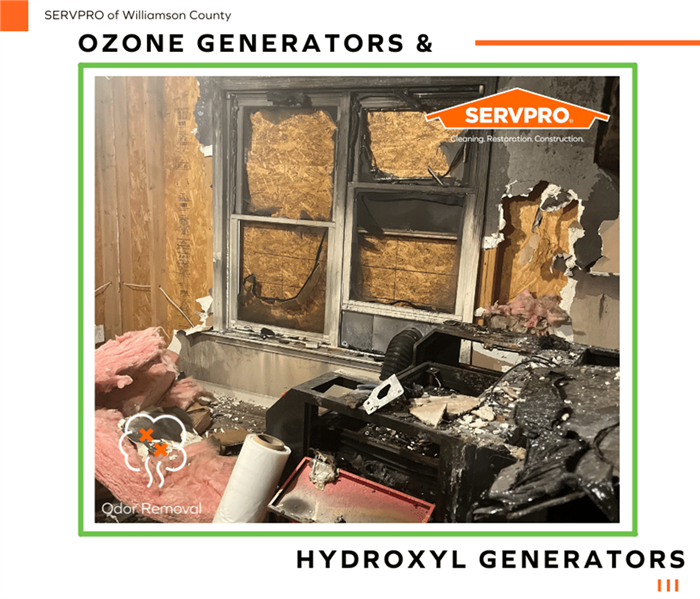 SERVPRO of Williamson County is here to serve you with 24/7/365 fire damage restoration services. Call us for rapid service!
SERVPRO of Williamson County is here to serve you with 24/7/365 fire damage restoration services. Call us for rapid service!
At SERVPRO of Williamson County, we understand how devastating a fire can be to your home or business. When it comes to fire damage restoration, addressing smoke and soot odors is a crucial step in returning your property to its preloss condition. As a leader in the restoration industry, we leverage cutting-edge technologies to tackle stubborn odors and ensure a thorough cleanup. In this blog post, we'll explore the role of ozone generators and hydroxyl machines in smoke and soot deodorization, highlighting their importance in modern fire damage restoration.
Understanding Smoke and Soot Odors
Smoke and soot particles are the byproducts of incomplete combustion, and their chemical composition makes them cling to surfaces and linger in the air long after the fire is extinguished. The odors they produce are not only unpleasant but can also pose health risks. Therefore, effective deodorization is essential during fire damage restoration to protect the well-being of occupants and restore the property to a habitable state.
Ozone Generators: A Powerful Tool for Smoke and Soot Deodorization
Ozone generators are widely used in the fire damage restoration industry for their potent odor-neutralizing capabilities. These devices work by producing ozone (O3), an unstable molecule that effectively oxidizes odor-causing particles on contact. Ozone generators apply an electrical charge to the air that splits apart some normal oxygen atoms into unstable single atoms, which bond with other oxygen molecules to form ozone. The extra oxygen atom in ozone reacts with the odor-causing molecules, breaking them down and neutralizing the smell.
Ozone is particularly effective against smoke and soot odors because it can penetrate porous materials and hard-to-reach areas, ensuring a thorough deodorization process. However, it's essential to know that ozone can be harmful to people, pets, and plants, so proper safety measures must be taken when using ozone generators. At SERVPRO of Williamson County, our trained technicians follow strict safety protocols and industry best practices to ensure a safe and effective deodorization process.
Hydroxyl Machines: A Safer Alternative for Sensitive Environments
Hydroxyl machines are another innovative technology used in fire damage restoration for smoke and soot deodorization. These devices produce hydroxyl radicals, which are highly reactive molecules capable of breaking down odor-causing compounds. They use UV-C radiation technology, similar to the sun's ultraviolet rays to break apart water vapor. The process creates hydroxyl radicals (OH) that decompose chemicals in the air. Hydroxyl radicals are naturally occurring in Earth's atmosphere and play a vital role in keeping our air clean.
One of the main advantages of hydroxyl machines is that they are safe for use in occupied spaces. Unlike ozone, hydroxyl radicals do not pose a risk to people, pets, or plants, making them a more suitable option for sensitive environments, such as healthcare facilities, schools, or homes with elderly residents or individuals with respiratory issues.
While hydroxyl machines are generally slower-acting than ozone generators, they are still highly effective in neutralizing smoke and soot odors. SERVPRO of Williamson County's expert technicians will assess the specific needs of your property and select the most appropriate technology for the deodorization process.
Trust SERVPRO of Williamson County for Effective Smoke and Soot Deodorization
When it comes to fire damage restoration, addressing smoke and soot odors is paramount. At SERVPRO of Williamson County, we are committed to providing the most effective and advanced solutions for smoke and soot deodorization. Our professional and compassionate team will work diligently to restore your property, giving you peace of mind during a challenging time. Our expert technicians are trained in the safe and proper use of ozone generators and hydroxyl machines, ensuring a thorough and successful restoration process.
If you need professional help with fire damage restoration and smoke and soot deodorization, don't hesitate to call SERVPRO of Williamson County at (615) 790-9634. Our team of experts is available 24/7 to assist you in getting your property back to its pre-fire condition.
Don't Let Smoke and Soot Odors Linger – Contact our SERVPRO of Williamson County Team Today!
4 Types Of Biohazardous Materials And Their Cleanup: What You Need To Know
5/4/2023 (Permalink)
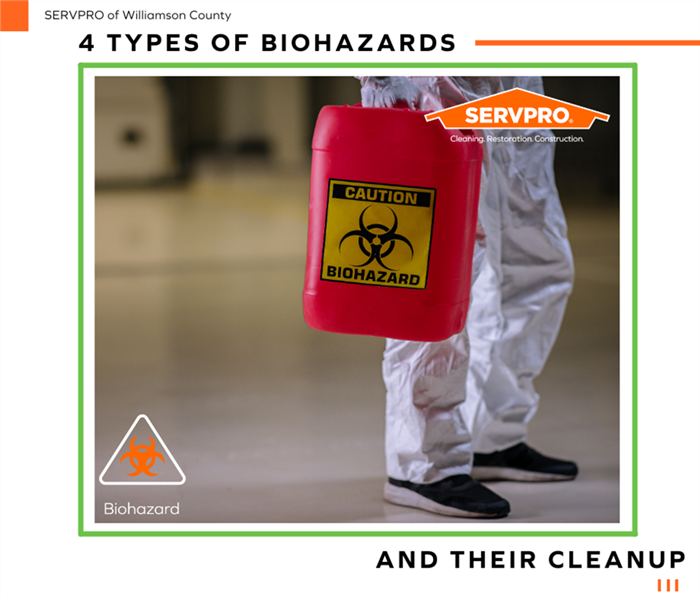 SERVPRO of Williamson County has the expertise to handle any form of biohazard removal and cleanup throughout Williamson County, TN.
SERVPRO of Williamson County has the expertise to handle any form of biohazard removal and cleanup throughout Williamson County, TN.
Biohazardous materials require special handling and cleaning in order to safely remove them from the environment. This article will discuss four types of biohazardous materials and their associated cleanup procedures, providing readers with a comprehensive overview of what is needed for safe removal.
Biohazards come in many forms, but all pose a significant risk if not handled properly. Some examples include human tissue, blood, bodily fluids, food waste, animal waste, and other potentially infectious materials. Each type has its own unique set of safety protocols that must be followed when disposing of it in order to protect both individuals and the environment from contamination.
The different categories of biohazardous material have varying levels of toxicity and potential health risks associated with them. Understanding each category’s specific requirements is essential for ensuring proper disposal practices and avoiding any complications down the line. Thankfully, our SERVPRO of Williamson County team is trained to handle any kind of biohazard effectively and completely. However, by learning more about these materials and how best to handle them during cleanup, readers can ensure that they are taking all necessary precautions when removing dangerous hazards from their homes or businesses.
Bloodborne Pathogens and Bodily Fluids
Bloodborne pathogens are microorganisms found in human blood and other bodily fluids that can cause serious illnesses such as hepatitis B, HIV, or even death. Biohazard cleanup of these materials is essential for protecting the health and safety of individuals who may come into contact with them. Proper disinfection protocols must be followed to ensure all potentially infectious material is thoroughly removed and appropriately disposed of. This includes biohazard abatement of areas where potential exposure has occurred, biomedical waste disposal, and biohazardous waste removal from contaminated sites.
Here at SERVPRO, we ensure technicians performing biohazard cleanups receive the IICRC Trauma and Crime Scene Technician Certification before performing biohazard cleanup projects. There are many different products available on the market designed to effectively remove hazardous contaminants while minimizing any risk associated with their handling. The use of safe chemical agents along with proper personal protective gear will help reduce the chance of contamination during the process. Additionally, workers should be familiar with local regulations regarding the appropriate disposal methods for any type of hazardous material encountered during a cleanup operation.
Microbiological Wastes
Microbiological wastes are materials that may contain viruses, bacteria and other infectious material. These materials must be managed properly to prevent the spread of disease and contamination of the environment. There are a number of specific protocols for biohazard cleanup, decontamination and disposal that need to be followed in order to ensure safety:
- Biohazard Cleanup: Properly disposing of contaminated materials is essential during biohazard cleanup. This includes personal protective equipment (PPE) such as gloves, masks, eye protection and suits; proper use of disinfectants and detergents; cleaning methods appropriate for each type of surface; and safe disposal options like incineration or autoclaving.
- Infectious Material Decontamination: In addition to proper disposal, infectious material must also be decontaminated using approved procedures. This typically involves thorough washing with an appropriate chemical agent before placing it in sealed containers for transport off-site. Disinfection can also involve using ultraviolet light radiation, ozone gas or other means depending on the nature of the material being treated.
- Biohazard Waste Management: Managing biohazardous waste requires careful planning from both healthcare institutions and environmental service providers. It begins by properly labeling all waste containers so they cannot be misidentified later on when transferred off-site. Once collected at designated collection points, biological waste should then be stored in secure locations until it can be transported safely away from populated areas following government regulations concerning its treatment and final disposition where applicable. At SERVPRO, our team specializes in handling biological waste removal and cleanup appropriately.
These measures help ensure effective containment, removal and destruction of potentially dangerous biological agents found within microbiological wastes before their impact can reach the general population or our fragile ecosystems.
Pathological Waste
Pathological waste often refers to biohazardous materials that are generated from the diagnosis, treatment, immunization or research of humans and animals. The most common types of pathological waste include animal carcasses, body parts, tissues, blood products and cultures. In some cases, even medical equipment may be classified as a hazardous material due to its potential for contamination.
Biohazard remediation is necessary when dealing with pathological waste because these items can contain biological agents such as bacteria or viruses. Proper disposal methods must be followed in order to prevent infection and minimize environmental hazards. Professionally trained technicians should handle any removal and cleanup processes required for proper biohazardous material disposal.
Contamination caused by exposure to pathological waste requires professional biological contamination cleanup services like trauma scene cleanup or infection control procedures as outlined by the IICRC. These specialized techniques take into account both safety protocols and ethical considerations regarding human remains during the recovery process. Technicians use specialized equipment such as protective gear and decontaminants to safely clean up the affected area while following specific guidelines governing hazardous materials management programs. With their expertise, they can help reduce risk of further exposure while restoring the environment back to its original condition before the incident occurred.
The next section covers sharps and other hazardous objects which require special care when disposing due to their potential for causing injury or illness if not handled correctly.
Sharps And Other Hazardous Objects
Sharps and other hazardous objects are items that can cause injury if handled improperly. Sharps include hypodermic needles, lancets, scalpels, broken glassware and any other item with a sharp point or edge which may be contaminated with biohazards such as blood-borne pathogens. These pose both an occupational health risk to cleanup personnel and potential environmental hazards if not disposed of properly. It is essential that these materials are removed safely in order to prevent contamination and the spread of infection.
In addition to sharps, there are numerous other hazardous materials associated with biohazardous waste including:
- Chemicals – chemicals used in medical laboratories such as formaldehyde, xylene and phenol must be handled with extreme care due to their toxicity.
- Radioactive Materials – radiation therapy equipment generates radioactive materials which can present a significant hazard if mishandled during cleaning operations.
- Pathogenic Agents - biological agents such as bacteria, viruses, fungi and parasites must all be contained from spreading beyond the area being cleaned.
The presence of sharps and other hazardous material necessitates the use of professional biohazard cleanup services like ours at SERVPRO of Williamson County. Our biohazard cleanup and restoration technicians are capable of managing the safe removal of these substances from the site while minimizing any exposure risks for anyone who lives in or works in the affected area.
The Role Of Professional Biohazard Cleanup Services
Biohazardous materials and their cleanup can be a daunting task, requiring specialized expertise and equipment. Professional biohazard cleanup services are available to safely remove hazardous material from the site of an incident and restore it back to its original condition. These services include decontamination, property damage restoration, disposal of contaminated items, and disinfection.
Decontamination is essential for removing potentially infectious material from surfaces where it has been deposited or spilled. Property damage restoration involves repairing any physical destruction that occurred due to the contamination. This might involve replacing fixtures, drywall, flooring etc., depending on the level of contamination and extent of damage caused by the incident. Disposal of all contaminated items must follow proper regulations in order to ensure they do not cause further harm to people or environment. Finally, thorough disinfection eliminates pathogenic microorganisms from surfaces with chemicals designed specifically for this purpose.
Here at SERVPRO of Williamson County our personnel involved in professional biohazard cleanup go through extensive training to understand safety and regulatory protocols along with how to use the specialized tools and personal protective equipment (PPE) to complete projects thoroughly and successfully.
Conclusion
In conclusion, it is important to understand the various types of biohazardous materials and their cleanup. Bloodborne pathogens and bodily fluids, microbiological wastes, pathological waste, and sharps and other hazardous objects are all dangerous substances that require specialized procedures for handling and disposal. Understanding the different types of biohazardous materials and their associated risks is essential for maintaining a safe environment in homes, businesses, and public spaces. By following proper cleanup procedures and relying on the expertise of professional biohazard cleanup services like SERVPRO of Williamson County, you can help prevent the spread of diseases and ensure the safety and well-being of your community.
The Dangers of DIY Sewage Cleanup: Why It's Best to Call in the Professionals
5/1/2023 (Permalink)
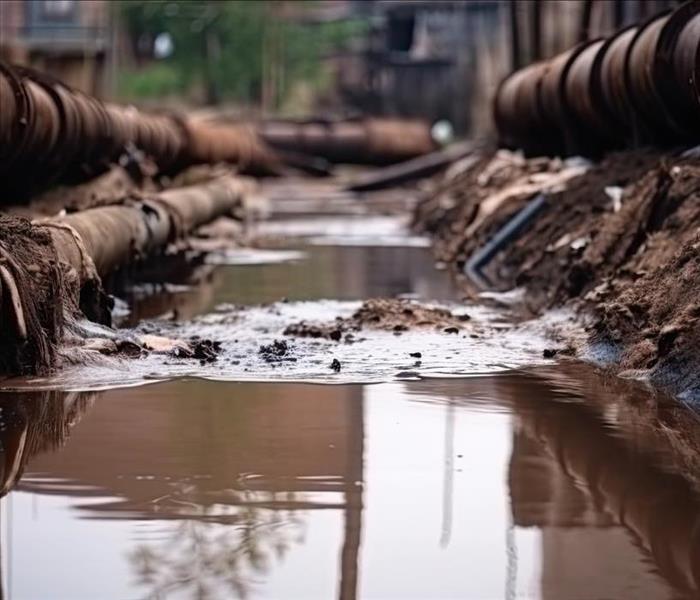 Whether you live in Franklin, TN or surrounding areas, SERVPRO of Williamson County is ready to respond to your call 24/7/365.
Whether you live in Franklin, TN or surrounding areas, SERVPRO of Williamson County is ready to respond to your call 24/7/365.
Experiencing a sewage backup in your home or business can be a daunting and overwhelming experience. While it may be tempting to try to tackle the problem yourself to save some money, attempting a DIY sewage cleanup can be hazardous and ultimately, more costly in the long run. In this blog post, we will explore the dangers of attempting to clean up sewage on your own and explain why it's best to call in professionals like SERVPRO of Williamson County water damage restoration and sewage cleanup services.
Understanding the Health Risks Associated with DIY Sewage Cleanup
Sewage backups can be both hazardous and potentially deadly when homeowners attempt to address the issue themselves. Sewage can consist of greywater (from utilities like sinks, tubs, showers, and dishwashers) or, even worse, black water, which is the water used to flush toilets mixed with the human waste that it flushes away. Besides human waste, chemical compounds and cleansers in sewage produce phosphorus and nitrogen pollution that can damage waterways and pose serious risks when entering your home. Sewage backups in your home can result from various causes, such as clogs in the home's drain pipes, tree roots, damaged sewer lines, and more.
Sewage contains up to one million microorganisms per millimeter of waste, some of which are vital for breaking down solid waste. However, pathogenic bacteria are also present and can cause health problems such as Hepatitis A and Encephalitis. Due to its ability to seep into porous materials, sewage is challenging to clean up by hand.
Furthermore, sewage contains parasitic microorganisms, such as polio, adenovirus, and enteric cytopathic human orphan (ECHO) viruses, which can cause severe health issues in humans. While the ratio of viruses to bacteria is relatively small, they are still harmful to your health. Wastewater also hosts pathogenic and saprophytic bacteria, including E. coli, Giardia Lamblia, Salmonella, and Pseudomonas aeruginosa. Direct exposure to these toxins can lead to intestinal diseases, typhoid fever, cholera, and dysentery. That is why coming into contact with sewage without wearing personal protective equipment (PPE) and following proper procedures can pose a severe threat to your health.
Mold growth is another significant risk when attempting DIY sewage cleanup. Mold exposure can worsen allergy and asthma symptoms, especially in children and individuals with compromised immune systems. Flooding provides ideal conditions for mold to develop, as it only needs moisture, organic material, and optimal temperature. Alarmingly, mold can grow within just 24 to 48 hours of the incident.
However, the greatest danger is sometimes not the risk of disease, but the risk of electrocution or explosion. Never enter a flooded area or light matches until the utility companies have shut off the electric and gas service. If you detect or smell gas, immediately evacuate your home and notify the gas company. You should also enter your home with caution if you did not turn off the main power switch before the flooding occurred. Touching electrical lines, wires, equipment, and fixtures during and after a flood can be dangerous.
Addressing the underlying plumbing issue is crucial to prevent future sewage backups. Failing to fix the problem correctly can lead to recurring spills and increased costs. It's worth noting that most home insurance policies cover sewage cleanup, so hiring professionals like SERVPRO of Williamson County is a practical and cost-effective solution.
The Importance of Proper Protective Gear and Equipment in Sewage Cleanup
Handling human waste or sewage comes with an increased risk of illness from waterborne diseases. Anyone involved in sewage cleanup must follow proper hygiene practices and wear appropriate personal protective equipment (PPE) to minimize the risk of contracting diseases such as the ones mentioned earlier in this article. SERVPRO restoration technicians are trained to prioritize health and safety while dealing with sewage cleanup tasks.
Basic Hygiene Practices for Restoration Technicians
- Always wash hands with soap and water after handling human waste or sewage, before eating or drinking, and before and after using the toilet.
- Avoid touching your face, mouth, eyes, nose, or open sores and cuts while handling human waste or sewage.
- Keep open sores, cuts, and wounds covered with clean, dry bandages.
- Use waterproof gloves to prevent cuts and contact with human waste or sewage.
- Wear rubber boots at the worksite and during transport of human waste or sewage.
- Refrain from smoking or chewing tobacco or gum while handling human waste or sewage.
- Gently flush eyes with safe water if human waste or sewage contacts them.
Restoration techs who handle human waste or sewage are always provided with proper PPE, training on how to use it, and handwashing facilities. The following PPE is typically required for restoration technicians handling human waste or sewage:
- Goggles: to protect eyes from splashes of human waste or sewage.
- Protective face mask or splash-proof face shield: to protect nose and mouth from splashes of human waste or sewage.
- Liquid-repellent coveralls: to keep human waste or sewage off clothing.
- Waterproof gloves: to prevent exposure to human waste or sewage.
- Rubber boots: to prevent exposure to human waste or sewage.
To further protect restoration technicians from exposure, employees are typically required to have their Tetanus vaccinations up to date, and in most cases polio, typhoid fever, Hepatitis A, and Hepatitis B vaccinations as well. Adhering to these best practices and procedures ensures the health and safety of workers handling sewage cleanup tasks. That is also why sewage cleanup and related water damage restoration can become more expensive and dangerous for a DIY restorer.
The Role of Industry Standards and Certification in Professional Sewage Cleanup Services
Professional water damage restoration and sewage cleanup companies like SERVPRO of Williamson County adhere to strict industry standards and guidelines to ensure that their work is effective, safe, and compliant with local regulations. Many restoration companies hold certifications from organizations like the Institute of Inspection, Cleaning and Restoration Certification (IICRC), which sets forth best practices for handling sewage cleanup projects.
The IICRC establishes and promotes globally recognized standards, including the IICRC S500 and IICRC S520, for water damage restoration and mold remediation, respectively. The IICRC S500 focuses on principles of water damage restoration, safety, and health, while the IICRC S520 covers mold remediation and abatement procedures. These standards provide a comprehensive framework for professionals to follow when dealing with sewage cleanup and water damage restoration projects.
By hiring a certified professional, you can be confident that your property will be cleaned and restored according to the highest standards of quality and safety. Certified professionals undergo rigorous training and examinations to demonstrate their competence in adhering to industry standards. Additionally, many professional sewage cleanup companies maintain affiliations with other relevant industry organizations, such as the Restoration Industry Association (RIA) and the Indoor Air Quality Association (IAQA), further ensuring their commitment to upholding best practices.
When you choose a professional sewage cleanup service with IICRC certification and affiliations to relevant industry organizations, you can trust that your property will be restored with the utmost care, professionalism, and adherence to industry guidelines. This not only guarantees the safety and health of those using the property but also provides peace of mind that the cleanup process will be completed with the highest level of expertise. This total peace of mind can be lacking in a DIY sewage cleanup project.
Finding the Right Sewage Cleanup Company: Questions to Ask and Factors to Consider
When looking for a professional sewage cleanup company, it's essential to do your research and ask the right questions. Some factors to consider include:
- Experience and expertise: Look for a company that specializes in water damage restoration and sewage cleanup, with a track record of successful projects.
- Certification and training: Make sure the technicians are trained and certified by reputable industry organizations like the IICRC.
- Insurance and liability coverage: Verify that the company has proper insurance coverage to protect you from potential liability.
- Availability and response time: Choose a company that offers 24/7 emergency services and can respond quickly to your needs.
Attempting a DIY sewage cleanup can be dangerous and may result in long-term damage to your property and health risks for you and your family. Instead, trust the professionals at SERVPRO of Williamson County for comprehensive water damage restoration and sewage cleanup services. Our certified technicians have the experience, equipment, and expertise to ensure that your home or business is thoroughly cleaned, sanitized, and restored to its pre-damage condition.
By choosing a professional sewage cleanup company like SERVPRO of Williamson County, you can have peace of mind knowing that your property is in the hands of experienced and certified experts who are committed to delivering the highest quality service.
Don't put your health and property at risk by attempting a DIY sewage cleanup. Call SERVPRO of Williamson County today at (615) 790-9634 for more information on our water damage restoration and sewage cleanup services. Let our team of restoration professionals help make it "Like it never even happened."
Tips to Stay Safe during Fire Damage: SERVPRO of Williamson County
3/29/2022 (Permalink)
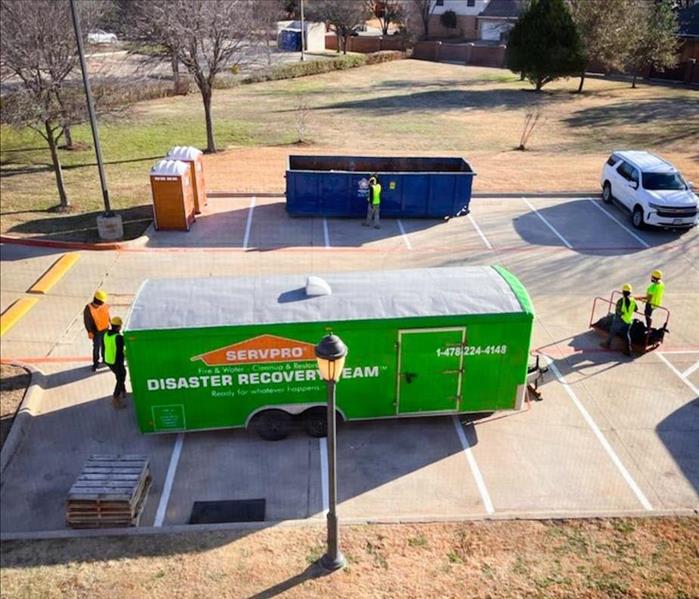 No matter how serious your property damage may be, SERVPRO of Williamson County is your local expert for restoring your home or business.
No matter how serious your property damage may be, SERVPRO of Williamson County is your local expert for restoring your home or business.
It's that time of year again - fire season in Williamson County, TN, and surrounding areas. Between February and May, the weather gets hotter and drier, while the risk of house fires rises. A fire may start from a variety of sources, ranging from a faulty wire to an overloaded outlet to a kitchen mishap to a bonfire left unattended. It's critical to know how to react quickly and effectively if your home catches fire.
Here's What You Need To Know If A Fire Starts:
The first line of defense against a house fire is to know how to use the proper fire extinguisher for the situation. This simple procedure can help save lives and hundreds of thousands of dollars in property damage. If the fire spreads uncontrollably, evacuate immediately and stay away, then call 9-1-1. Leave all of your belongings where they are and save yourself and your loved ones.
If your clothing ignites, remember the old adage: Stop, Drop, and Roll.
It's critical to utilize the stairs if you live in a building with elevators in case of a fire. The elevator electrical system may be damaged by a fire, causing the shaft to operate like a chimney and rapidly fill up with deadly fumes.
Doors may be used to your advantage in a fire, potentially saving your life. If the doorknob or handle is hot, don't open it. If you can't exit through the primary route, look for another option. Do not open any doors that are warm to the touch.
Close any doors that might obstruct your exits, lay a wet towel beneath the doors, and call the fire department or 9-1-1 if flames, heat, or fire block your avenues of escape. Tell them exactly where you are so they can find you.
If you're near a window that you can't use as an escape, open it and wave a brightly colored cloth or use your phone flashlight to signal for help.
What To Do After a Fire
After a fire, it is important to contact a professional fire damage restoration company like SERVPRO of Williamson County. We have the training, experience, and equipment to properly restore your home - "Like it never even happened."
If you try to clean up the fire damage yourself, you could end up making the situation worse both in your home and with your insurance company's process.
Trust the experts, and call today!
4 Advanced Home Maintenance Tips That Can Save You Thousands of Dollars in Property Damage: SERVPRO of Williamson County
3/9/2022 (Permalink)
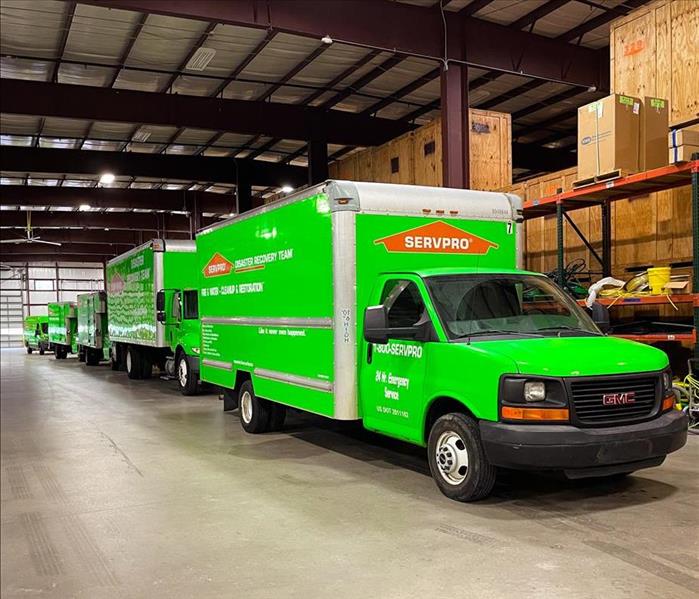 SERVPRO of Williamson County keeps its trucks ready to respond immediately to your water damage emergency.
SERVPRO of Williamson County keeps its trucks ready to respond immediately to your water damage emergency.
Did you know? An average of 14,000 people experience home water damage emergencies every day.
Water damage is a serious problem that can be expensive and inconvenient in your home or business in Franklin, TN. SERVPRO of Williamson County frequently finds that careful housekeeping may help to minimize the danger and costs of water damage repair. The process of water damage restoration, while unpleasant, may be reduced by implementing some basic housekeeping techniques.
1) Inspect & clean the HVAC condensation lines to prevent leaks or flooding.
HVAC condensation lines tend to leak water when clogged and on especially hot months, this can cause water damage and flooding in surrounding areas of your home. Inspect your condensation lines every month and clean them as needed.
You should pour one-half cup of plain, white vinegar four times a year down your condensate drain to clear out gunk and debris. Bleach should not be used since it might spill onto your metal drain pan and cause deterioration and issues. If you find excessive debris or mold, our SERVPRO professionals can help you cleanup any water damage.
2) Inspect and clean the roof and gutters of debris and check attics for signs of water damage.
Clogged gutters can cause rainwater to back up and overflow onto your roof, which can damage the roofing material and seep into the home.
Check for leaking flashing around vents, valleys, chimneys, pipes, and skylights. Any place where your roof has holes or joins is a potential source of leaks later on down the road. If this flashing becomes bent, rusted, or loses its seal, it might allow water to enter your property.
Examine your attic for moisture or mold growth. If you detect damp, damaged, or moldy insulation, rotted or discolored boards or ceiling panels, or puckering in the sheetrock, you may have a leak on your hands.
3) Have a professional inspect your plumbing system
One of the best ways to avoid needing emergency water repair is by scheduling plumbing maintenance. Maintenance allows a plumber to check your plumbing system for any developing corrosion or pinhole leaks that you may not notice otherwise. They can also try to determine when your plumbing system will need repairs, so you aren't caught off guard by any water leaks in the future.
Meanwhile, avoid flushing unusual or insoluble objects down toilet drains to prevent clogging that leads to floods. If you experience three or more water leaks in less than six months, your pipes may need to be replaced.
4) Test your sump pump thoroughly for possible water leak issues
A sump pump protects your home from heavy rains and rising waters that leave behind enormous repair costs and structural damages.
Conclusion
It is important to be proactive about home maintenance and repairs in order to prevent water damage events from happening in the first place. However, if a water damage event does occur, it is important to have a plan in place for how to deal with the aftermath. Our team of experts at SERVPRO of Williamson County is Here to Help!
Call us today: (615) 790-9634
Understanding Secondary Water Damage
2/10/2022 (Permalink)
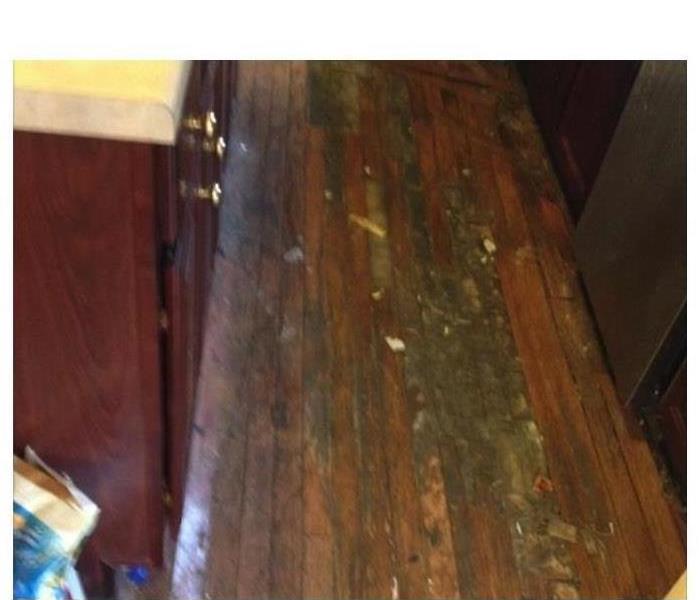 Mold on hardwood floors.
Mold on hardwood floors.
When you have a plumbing emergency in College Grove, TN, that causes water damage in your home, proper cleanup is essential. If your cleaning is only surface-level, long-term secondary damage can set in, leading to more problems down the road. High humidity from water that is not properly removed can lead to black mold and other issues over time.
Understanding Secondary Effects of Water Damage
While it’s impossible to tell exactly what secondary effects will look like, there are a few known processes that happen when water is not removed and secondary issues set in.
- Black mold growth in humid, warm areas where water is trapped
- Atmospheric problems from mold spores and abnormal humidity
- Warping of wood materials and visible damage to surfaces from long-term water exposure
- Degradation of concrete, drywall, and other building materials over time
Depending on the extent of the damage and the level of cleanup applied, these effects could show up as structural weakening, stains, abnormal humidity levels, or a variety of other conditions.
Repairing Damage From Humidity
Working with a restoration cleaning service that understands water damage cleanup is the best way to repair secondary damage. This damage includes some hazards that might require special certifications for procedures like mold removal, so it is important to check for those credentials when you pick out a service provider.
Preventing Secondary Water Damage
If you want to make sure you do everything you can do to prevent secondary water damage from showing up years later, you need to work with water damage remediation professionals in College Grove, TN, who understand both the primary and secondary effects of water damage, and who have the certifications to handle both. That way, you can be sure your initial cleanup team understands black mold, high humidity, and other forms of secondary damage and acts to prevent or repair them during the cleanup process.
6 Hurricane Preparation Tips for Businesses
2/5/2022 (Permalink)
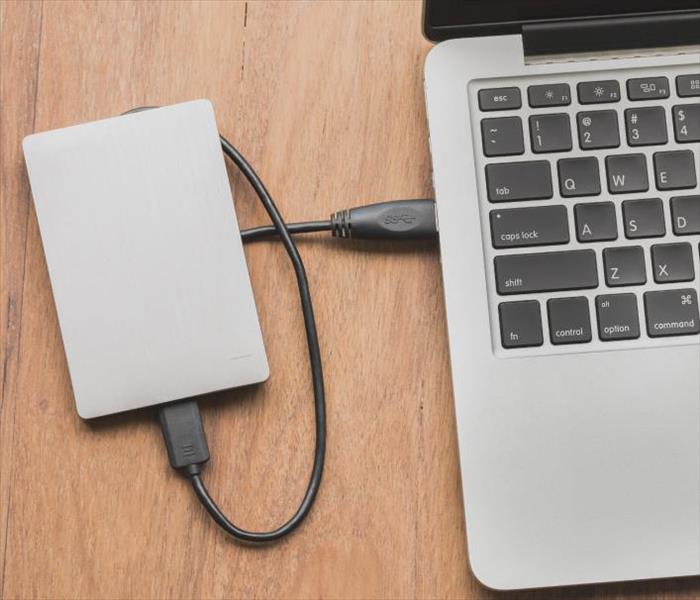 Keep computer files backed up on an external hard drive or cloud in case of an emergency.
Keep computer files backed up on an external hard drive or cloud in case of an emergency.
Storm Tips For Businesses
For six months each year, businesses in and near coastal communities, such as Spring Hill, TN, are vulnerable to hurricane damage. Unlike other severe storms, hurricanes rarely occur unexpectedly. As a result, business owners usually have ample time to safeguard their property. Following six key measures can help every commercial organization prepare for these potentially devastating storms.
1. Shield Windows
During a hurricane, high winds can send debris flying, leaving glass doors and windows vulnerable to shattering. For this reason, it’s imperative that you shield these structures with plywood or shutters.
2. Trim Trees
Tree limbs near your building can also damage infrastructure. To alleviate this concern, you should keep landscaping neatly trimmed and routinely remove dead branches.
3. Raise Important Equipment
Significant rainfall can cause flooding. To prepare for this possibility and avert catastrophic water damage, you should elevate essential equipment, such as vital components of your HVAC system.
4. Erect Sandbag Barricade
Flooding can be an extremely destructive form of hurricane damage for numerous reasons. In addition to damaging equipment, severe water inundation can also saturate carpets, drywall and insulation, increasing the risk of mold contamination. To minimize these risks and help divert water away from your building, you can erect a sandbag barricade.
5. Protect Electronic Equipment
Protecting computers, printers and other electronic equipment may also be a priority. To shield these devices from water damage, you should turn them off, unplug every cord and wire and then wrap the unit in plastic.
6. Backup Important Documents
Important documents may not survive the storm. Because of this risk, you should safely store backup copies of employee files, legal documents and financial records offsite. You can also attempt to salvage onsite documents by placing them inside waterproof containers.



 24/7 Emergency Service
24/7 Emergency Service









